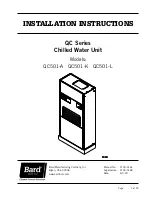
19
18.03. 5719210_03
ANL / 290-650
EN
to (U) phase, (N) neutral, (PE) earth in the case
of single phase units (230V/50Hz),
8.
U-V-W for phases, N for neutral and PE
for earth in the case of three phase units
(400V/3N/50Hz).
9.
Replace the inspection panels.
10.
Ensure that all protection removed for the elec-
trical connection are replaced before powering
the unit.
11.
Place the main isolator (external to the unit)
to “ON”.
9.
CHECKS AND FIRST START-UP
9.1. PREPARING FOR FIRST START-UP
It is reminded that for units of this series, if requested
by the Aermec client or the legal owner and only
on ITALIAN territory, free start-up is provided by the
regional Aermec technical assistance service. The
start-up must be previously agreed based on the
intended time of completion of installation. Before the
start-up all the works (electrical and hydraulic connec-
tions, filling and venting of air in the system) must be
completed.
9.2. START-UP
9.2.1. PRELIMINARY CHECKS BEFORE
POWERING UP
CHECK
:
1.
All safety precautions have been followed.
2.
The unit has been appropriately fixed to the
support base.
3.
Minimum clearance spaces have been ob-
served.
4.
Power supply cables are correctly sized and ca-
pable of supporting the electrical requirements
of the unit (see section on electrical data) and
that the unit is correctly earthed.
5.
All electrical connections are correctly termi-
nated and tightened.
9.2.2. CHECKS TO BE DONE WHEN POWERED UP
1.
Apply power to the unit by turning the main iso-
lator to the ON position. The display will power
up after several seconds after applying power,
check that the operating status is on OFF (OFF BY
KEYB on the lower part of the display).
2.
Check with a tester that the power supply volt-
ages on the phases U-V-W are 400V ±10%, check
that the phase imbalance is not greater than 3%.
3.
Check that the connections made by the installer
comply with the documentation.
4.
Check that the compressor crankcase heater(s)
are operating by measuring the increase of oil
sump temperature. The heater(s) must be in
operation for at least 24 hours before starting
the compressor, and in all cases the sump oil
temperature must be 10-15 K above ambient
temperature.
HYDRAULIC CIRCUIT
1.
Check that all hydraulic connections have been
correctly installed, that the instructions on the
labels have been followed, and that a mechani-
cal filter has been installed on the inlet to the
evaporator. (Mandatory component otherwise
the warranty will be voided).
2.
Confirm that the pump(s) are operating and that
the flow rate is sufficient to make the contact on
the flow switch.
3.
Check the water flow rate by measuring the
differential pressure across the evaporator inlet
and outlet and calculating the flow from the
evaporator pressure drop diagram provided in
the documentation.
4.
Check the correct functioning of any flow
switch installed; close the isolating valve on the
evaporator outlet and observe the result on the
unit display panel; open the valve and reset the
flow trip alarm.
9.3. FIRST START-UP
After having rigorously followed the above checks it is
possible to start the unit:
1.
Close the electrical panel.
2.
Turn the main isolator to ON.
3.
Press the key ON for 3 seconds to start the
unit.
Pressing the key ON displays the water
temperature and the operating mode of the unit.
Check the operating setpoint parameters and
reset any alarms present . After a few minutes
the unit will start.
9.3.1. CHECKS WITH THE UNIT RUNNING
REFRIGERANT CIRCUIT
CHECK:
- That the compressor input current of the compres-
sors is less than that indicated in the table of electri-
cal data.
- That in three phase models the compressor noise is
not abnormal, indicating a reverse rotation. In this
case reverse one of the phases.
- That the voltage values are within the determined
limits and that the phase imbalance (three phase
power) is less than 3%.
- Presence of any refrigerant leaks, in particular
from connections to gauges, pressure transducers
and pressostats. (Vibrations during transportation
may have loosened connections).
- Superheat
Compare the compressor suction temperature with
a contact temperature sensor reading with the
temperature of the low pressure gauge (saturated
suction temperature corresponding to the evaporat-
ing pressure). The difference between these two
temperatures is the superheat value. The optimal
values are between 4 and 8 K.
- Discharge temperature
If the values of sub-cooling and superheat are
normal the temperature measured in the discharge
line from the compressor must be 30/40 K above
the condensing temperature.
SAFETY AND CONTROL DEVICES
CHECK
:
- The manual high pressure pressostat, which stops
the compressor and generates and alarm when the
discharge pressure exceeds the preset value. The
correct operation is checked by closing the refriger-
ant isolating valve to the heat exchanger (in cooling
mode) and keeping a check on the high pressure
gauge, verify the operation corresponds to the rated
value. Warning: in the event the pressostat does
not operate at the rated value immediately stop
the compressor and investigate the cause. Reset is
manual but can only be done when the pressure
drops below the differential setting. (For the values
of the trip and differential setting refer to the tech-
nical manual).
- Anti-freeze protection
The electronic control of the anti-freeze protection
is from the water temperature sensor leaving the
evaporator prevents freezing of water when the
temperature is too low. The operation of the anti-
freeze protection can be checked by increasing the
setpoint value until it is above the temperature of
leaving water and checking the water temperature
with a high precision sensor. Confirm that the unit
stops and generates the responding alarm. After this
check reset the anti-freeze setpoint to the original
value.
Summary of Contents for Variable Multi Flow ANL 290
Page 27: ......










































